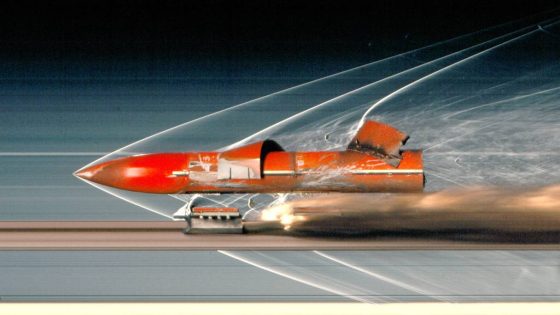The Pentagon is exploring options to build a second track to test hypersonic systems that can travel at speeds above Mach 5.
George Rumford, director of the Test Resource Management Center, told lawmakers this week the effort is in the study phase, but he expects adding another test track to the Defense Department’s inventory could offer a significant boost to hypersonic development efforts.
“The track we have now is 70-plus years old. It was originally designed to test ejection seats in airplanes,” Rumford said during a March 12 House Armed Services Strategic Forces subcommittee hearing. “If we’re really going to move after and get after testing hypersonics, we’re going to need a new track capability in our nation.”
The track Rumford referenced is located at Holloman Air Force Base in New Mexico and operated by the Arnold Engineering and Development Complex. It’s used for warhead and lethality testing and also to better understand the effect weather and erosion could have on a hypersonic weapon.
The department operates two other tracks — one at Eglin Air Force Base in Florida and another at China Lake in California — and has access to two more tracks in New Mexico and Utah. But at more than 50,000 feet long, only Holloman’s track — DOD’s longest — can achieve the speeds needed to test hypersonic systems.
The department has upgraded the Holloman equipment over the years, Rumford said, and there are plans for further modernization. But completing that work disrupts testing schedules, and having a new high-speed track would increase the capacity at a time when DOD is pushing to improve its testing cadence.
“As a nation, we need a new track,” he said. “When we modernize the track, we have to take the track offline for a period of time, which is the exact opposite of what we want to be doing when we’re trying to go fast and take on more risk.”
The Pentagon in recent years has been working to increase the number of hypersonic tests it can support, both in the air and on the ground. Its fiscal 2025 budget request, released March 11, includes $9.8 billion to develop hypersonic and other long-range missiles. It also proposes $163.4 million to support production, supply chain and test capabilities for hypersonic systems.
The department has a number of efforts underway to boost its testing capacity. On the ground, the TRMC is investing in improvements to government-owned test facilities and is partnering with private sector organizations to address shortfalls in propulsion testing for air-breathing hypersonic vehicles and aeroshell materials for boost-glide systems.
To boost its high-speed flight test enterprise, the organization is growing a fleet of modified Global Hawk uncrewed aircraft equipped with sensors and instrumentation to support hypersonic flight tests from the air. The program, dubbed SkyRange, has three Range Hawks on hand and has plans to convert more in the coming years.
In collaboration with the Naval Surface Warfare Center’s Crane Division, TRMC is also investing in the Multi-Service Advanced Capability Hypersonics Test Bed program, or MACH-TB, to create a flying testbed that can validate subsystems, advanced materials and other technologies as a system is being developed.
TRMC is also working with the Defense Innovation Unit to funnel emerging technology into MACH-TB through the Hypersonic and High-Cadence Airborne Testing Capabilities program, dubbed HyCAT. The goal of HyCAT is to leverage commercial innovation to make flight testing more affordable. Technologies matured through HyCAT will transition into MACH-TB.
Rumford said funding for these efforts is critical to support the department’s push to field hypersonic systems on faster timelines. Asked how his office would spend additional resources, he said any new money would support more flight tests.
On the other hand, Rumford said, a drop in funding would slow down the entire enterprise.
“It’s like molasses to an engine,” he said. “It slows everything down by not having that volume of flight throughput.”
Courtney Albon is C4ISRNET’s space and emerging technology reporter. She has covered the U.S. military since 2012, with a focus on the Air Force and Space Force. She has reported on some of the Defense Department’s most significant acquisition, budget and policy challenges.
Source Agencies




